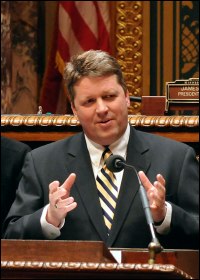A few weeks ago, I had my AP Students read an essay entitled “Bowling Alone,” by Robert Putnam. The premise of the essay is the idea that America is losing its social capital and that it has been on the decline for several years. Social capital refers to connections among individuals. It is the foundation for social communities.
Left intact, social capital has a stream of benefits, including safety and security, friendship and community, and a sense of civic identity. Putnam uses the analogy that even though more and more people are heading to the bowling alley these days, there is a decline in bowling leagues.
Politically speaking…voting, political knowledge, and grassroots political activism are all down. Americans sign 30 per cent fewer petitions and are 40 per cent less likely to join a consumer boycott, as compared to just a decade or two ago. Other social get-togethers have experienced a decline over the last 25 years. Attendance at club meetings have dropped 58 percent, family dinners are down 43 percent, and having friends over is down 35 percent since 1985 (Putnam 2000).
How far are we willing to go it alone? Have we lost our civic virtue? Have we lost our sense of community? As the state budget faces even more cuts, are cities and communities willing to let our hospitals and nursing homes close? Will we continue to invest in our schools, our main street, and our local food shelf? Do we care about our neighbors as fellow citizens? Is the mentality, “as long as I have mine” (insert job or health insurance here) the social norm?
Putnam states “a society of many virtuous but isolated individuals is not necessarily rich in social capital.” As a matter of fact, there is a range of evidence that communities with a good ’stock’ of such ’social capital’ are more likely to benefit from lower crime figures, better health, higher educational achievement, and better economic growth.
Yes, we can blame television, suburban sprawl, and the time constraints brought on with a two career family. However, generational change came out as a very significant factor. A “long civic generation,” born in the first third of the twentieth century, is passing from the American scene. Their children and grandchildren (baby boomers and Generation X-ers) are much less engaged in most forms of community life. For example, the growth in volunteering over the last ten years is due almost entirely to increased volunteering by retirees from the long civic generation.
As the New Year approaches, let’s consider what’s important to Minnesota: a state that embraces the importance of “the common good” and the virtues of civic responsibility and participation. This holiday season let’s not lose sight of our need to invest in social capital. Make time for the family meal, invite the neighbors over for some eggnog, attend a Holiday Concert, or make time to volunteer. And perhaps you can even find time to go bowling. Better yet, start a league.

 On Tuesday, October 6, the Commerce Committee of the Minnesota Senate met for a rare out of session hearing. The topic was ‘regulation of financial institutions in Minnesota.” The hearing was called in response to a few high profile bank failures that have occurred in several of our Minnesota communities this past summer. Like so many banks across the country, Minnesota small banks made several big bets on real estate and according to the Federal Reserve, Minnesota ranks fifth nationally in the number of banks with excessive levels of bad loans. Should we expect more banks to fail? Is there a problem?
On Tuesday, October 6, the Commerce Committee of the Minnesota Senate met for a rare out of session hearing. The topic was ‘regulation of financial institutions in Minnesota.” The hearing was called in response to a few high profile bank failures that have occurred in several of our Minnesota communities this past summer. Like so many banks across the country, Minnesota small banks made several big bets on real estate and according to the Federal Reserve, Minnesota ranks fifth nationally in the number of banks with excessive levels of bad loans. Should we expect more banks to fail? Is there a problem?
